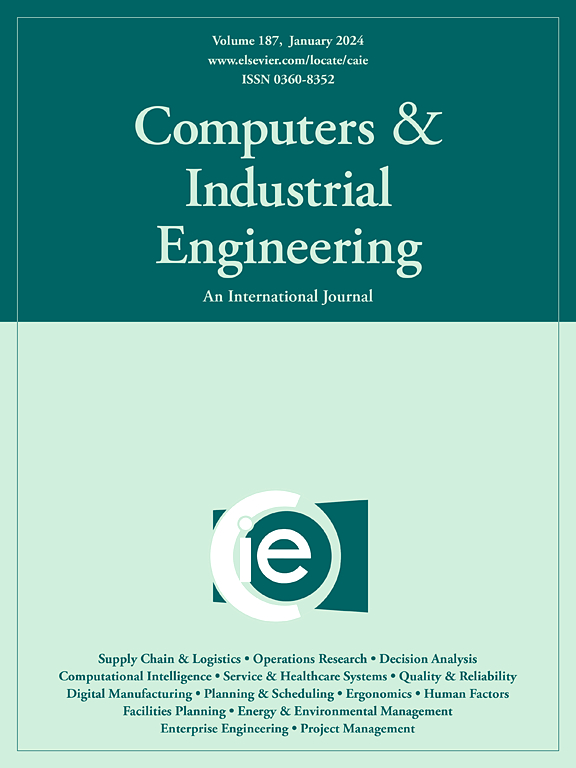Optimal order quantities of a multi-period inventory of compatible products
IF 6.5
1区 工程技术
Q1 COMPUTER SCIENCE, INTERDISCIPLINARY APPLICATIONS
引用次数: 0
Abstract
Effectively managing perishable inventory that consists of a heterogeneous assortment of mutually compatible products presents a complex and computationally challenging problem in operations research and supply chain fields. This particular problem arises when certain products can serve as substitutes for others, an operation commonly observed in maintenance parts, electronics, pharmaceuticals, batteries, and various other industries. Unlike single-period/single-product inventory models, where closed form solutions like the classical newsvendor are available in the literature, the compatibility between multiple products across multiple planning periods has remained largely unexplored in previous research.
Thus, the objective of our study is to find the optimal order quantities of different product types in an inventory system to minimize shortages and expiration, taking into account the challenging aspects of perishability and the existence of compatible substitutes. To rigorously address the complexities of this inventory system, a mixed-integer linear programming (MILP) framework is developed to encapsulate the intricate structural and operational characteristics of the problem. The proposed model is designed to accommodate both deterministic and stochastic scenarios, enabling the derivation of exact and approximate solutions through the integration of advanced optimization and simulation-based methodologies.
For large-scale instances, we recognize the computational challenges that arise when using standard solvers. Consequently, a metaheuristic algorithm is developed, which is specifically designed to reduce the computational time required to solve big instances. By tackling the interplay between perishability, compatibility, and multi periods, our study pushes the boundaries of existing research and presents innovative solution to real inventory where product substitution is allowed.
The findings showed that less shortages and expiration result in the case of compatible products. Compatibility also results in less order quantities. For a single inventory period, compatibility demonstrates higher effect on reducing the expected shortage and spoilage. For the case of full compatibility where any product can serve as a substitute for the others, closed form solution can be found for single period planning, while in multiple period planning, MILP optimization is required to address the problem. Finally, when compatibility is not present, it will lead to independent demand, thereby making the classical newsvendor problem applicable to this special case, but even in this case, optimization will be required for multi-period.
The proposed model exhibits broad applicability across a wide spectrum of industrial and medical applications, including but not limited to management of spare parts inventory, pharmaceutical supply chains, perishable food products such as dairy and ready-to-eat meals, the automotive sector, and systems involving modular subassemblies.
兼容产品多周期库存的最优订购数量
在运筹学和供应链领域,有效管理由相互兼容的异质产品组成的易腐库存是一个复杂且具有计算挑战性的问题。当某些产品可以作为其他产品的替代品时,这种特殊的问题就会出现,这种操作在维修零件、电子、制药、电池和其他各种行业中都很常见。与单周期/单产品库存模型不同,在文献中可以找到像经典报摊这样的封闭形式的解决方案,在以前的研究中,多个计划周期的多个产品之间的兼容性在很大程度上仍未被探索。因此,我们研究的目标是在考虑到易腐烂性和相容替代品的存在的挑战性方面,找到库存系统中不同产品类型的最佳订单数量,以最大限度地减少短缺和过期。为了严格解决该库存系统的复杂性,开发了一个混合整数线性规划(MILP)框架来封装该问题的复杂结构和操作特征。所提出的模型旨在适应确定性和随机场景,通过集成先进的优化和基于模拟的方法,能够推导出精确和近似的解决方案。对于大规模实例,我们认识到使用标准求解器时出现的计算挑战。因此,开发了一种元启发式算法,专门用于减少求解大型实例所需的计算时间。通过处理易腐性、兼容性和多周期之间的相互作用,我们的研究突破了现有研究的界限,并为允许产品替代的实际库存提供了创新的解决方案。研究结果表明,在兼容产品的情况下,短缺和过期较少。兼容性还会导致订单数量减少。对于单个库存周期,兼容性对减少预期短缺和损坏的效果更高。在完全兼容的情况下,任何产品都可以替代其他产品,单周期规划可以找到封闭形式的解决方案,而在多周期规划中,需要MILP优化来解决这个问题。最后,当不存在兼容性时,将导致独立需求,从而使经典的报贩问题适用于这种特殊情况,但即使在这种情况下,也需要对多周期进行优化。所提出的模型在广泛的工业和医疗应用中具有广泛的适用性,包括但不限于备件库存管理、制药供应链、易腐食品(如乳制品和即食食品)、汽车行业和涉及模块化子组件的系统。
本文章由计算机程序翻译,如有差异,请以英文原文为准。
求助全文
约1分钟内获得全文
求助全文
来源期刊

Computers & Industrial Engineering
工程技术-工程:工业
CiteScore
12.70
自引率
12.70%
发文量
794
审稿时长
10.6 months
期刊介绍:
Computers & Industrial Engineering (CAIE) is dedicated to researchers, educators, and practitioners in industrial engineering and related fields. Pioneering the integration of computers in research, education, and practice, industrial engineering has evolved to make computers and electronic communication integral to its domain. CAIE publishes original contributions focusing on the development of novel computerized methodologies to address industrial engineering problems. It also highlights the applications of these methodologies to issues within the broader industrial engineering and associated communities. The journal actively encourages submissions that push the boundaries of fundamental theories and concepts in industrial engineering techniques.
 求助内容:
求助内容: 应助结果提醒方式:
应助结果提醒方式:


